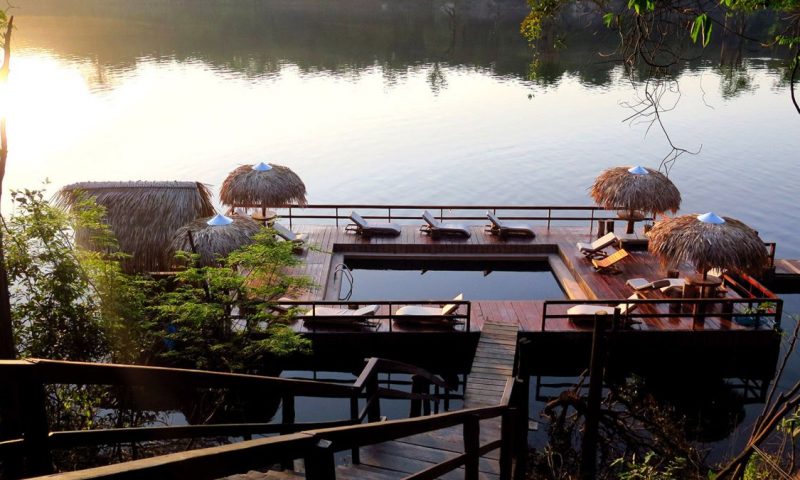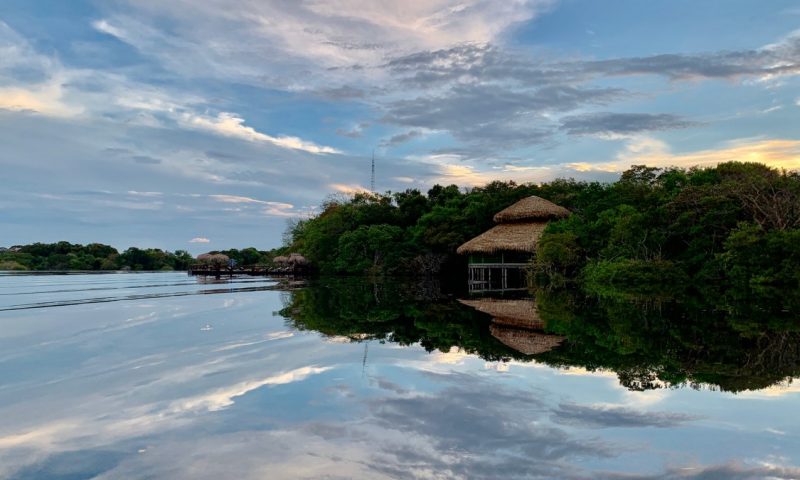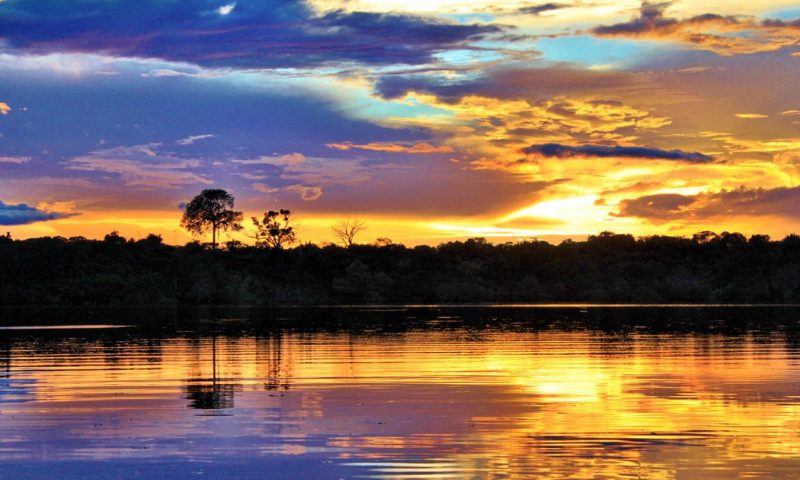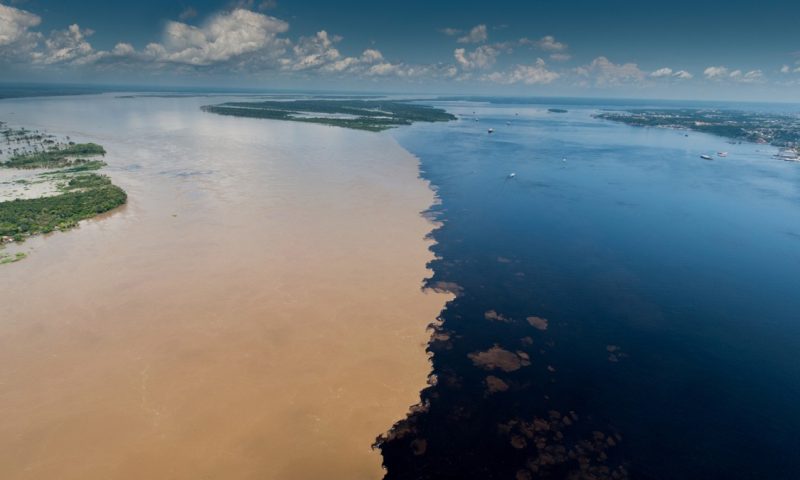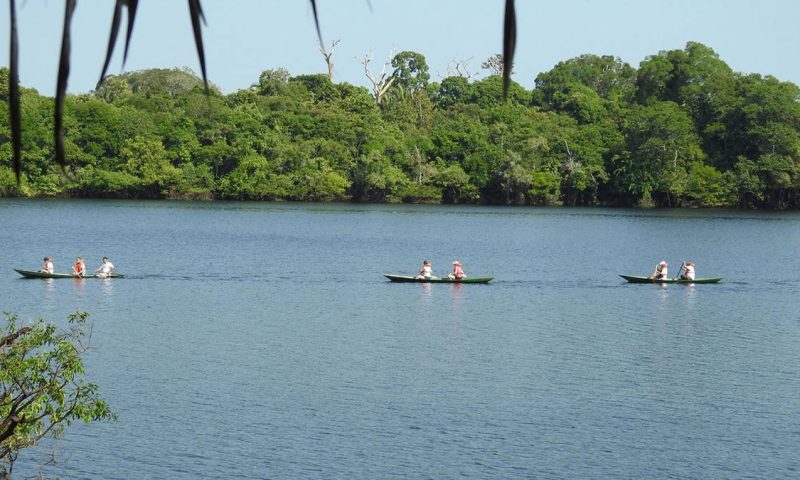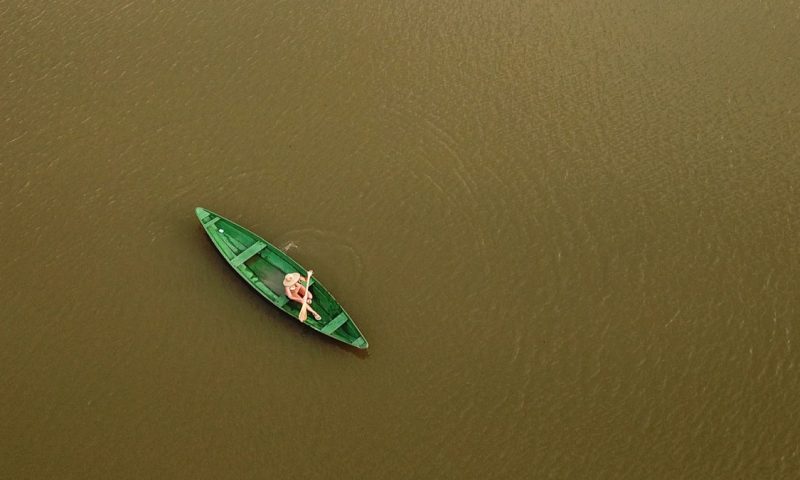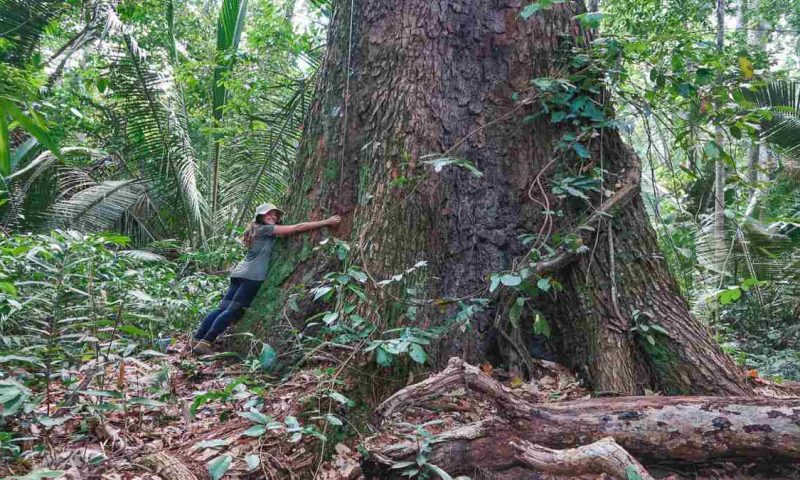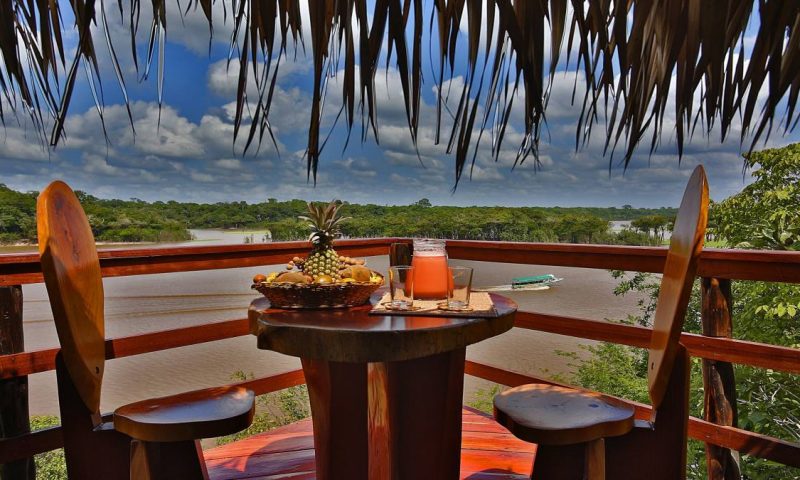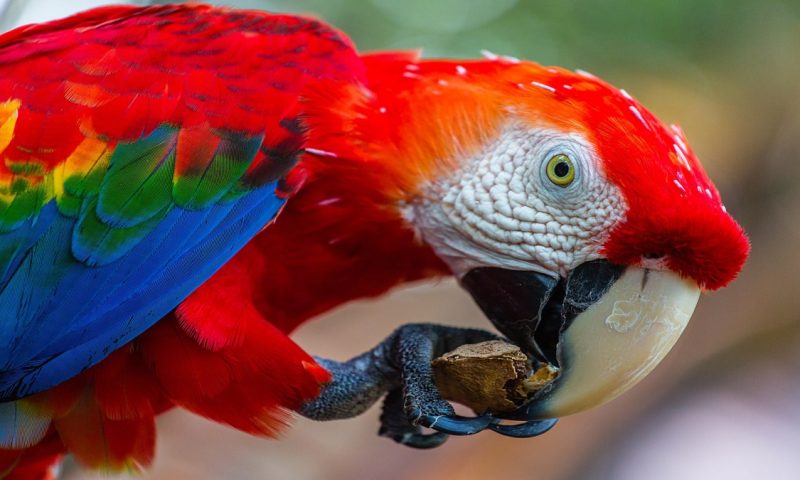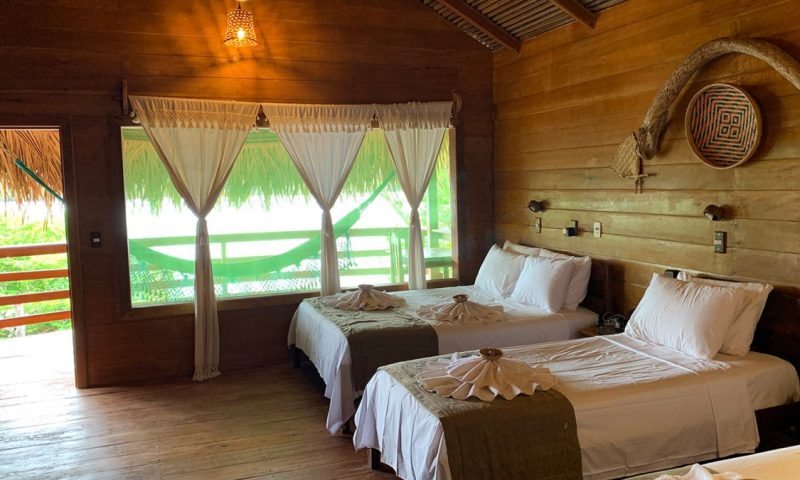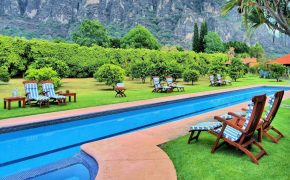With its prime location in one of the most remote and preserved regions of the Amazon Rainforest, Juma Amazon Lodge is an intimate and inviting property harmoniously nestled into the forest environment which defines it.
Juma Amazon Lodge features 19 intimate bungalows seamlessly nestled into the lush surroundings of the Amazon Rainforest. In order to accommodate the water levels of the wet season (often rising up to 15 meters, or 49 feet), the property was built on stilts upon solid ground resting at treetop level.
Juma Lodge is entirely eco-friendly in design and construction. All materials used in the construction of Juma are native and found abundantly in the region, carefully extracted from the surrounding area. Both the construction and the architectural style of the lodge reflect the techniques employed by Amazon River natives when building their own homes.
BUNGALOWS
Reflecting its environment, Juma Amazon Lodge is rustic yet beautiful, offering guests an optimized blend of authenticity and comfort. The lodge’s footprint is minimalist, yet elegant in concept. Six of our bungalows offer views of the surrounding forest, 12 are riverfront and one is panoramic.
All bungalows have private bathrooms with hot water solar systems, porches with hammocks and ceiling fans ideal for the Amazonian night, which tends to be far cooler than Manaus.
FOREST VIEW BUNGALOW
Bungalows overlooking the forest are located between the lobby patio and the restaurant. Their location allows for easy access for the elderly or anyone with any locomotive difficulty. Because the forest bungalows are closer to one another, they make for an excellent choice for families with small children.
RIVER VIEW BUNGALOW
Located in a more secluded and exclusive area of the lodge, our river view bungalows are nestled into the canopy of the trees, reaching 15 meters (49 ft) above the ground during dry season. Ensuring the utmost level of privacy, the river view bungalows were designed to be fully integrated into the forest.
FAMILY RIVER VIEW BUNGALOW
This bungalow also overlooks the Juma River, but it is larger, with 55 square meters (592 square feet). It has a king size bed and two single beds, making it perfect for families.
PANORAMIC BUNGALOW
The panoramic bungalow is our biggest bungalow! Located in the treetops, with 96 square meters (1033 square feet) in size, it is equipped with a king-size bed and features a round panoramic balcony with two hammocks and a complete and stunning view of the Juma River.
AMENITIES
Juma’s lobby is home to the lodge’s bar, where guests can entertain themselves with board and table games, books pertaining to the Amazon, painting materials and a professional telescope designed for moon and star observation.
The restaurant, specializing in both local and international cuisine, offers its guests an exceptional view of the Juma River. Served buffet style, the menu is constantly changing and offers a great variety of flavors. The hammock house is widely used by guests to rest and reflect after meals or after a day of jungle exploration.
Juma features two decks: a floating one, ideal for swimming in the river and sunbathing, and another one built on stilts located directly in front of the lobby and showcasing excellent views of the river.
Juma’s river pool was thought to be as authentic as possible, allowing full interaction with the river. Around it, it is possible to sunbathe and enjoy a small bar. We opened a museum to offer our guests more content and information about the Amazon Rainforest: its fauna, flora, customs, legends, among others.
“Tapiri” is an indigenous name for a hut. Although inside our property, it is located 10 minutes away from the hotel itself, serving as a base for tours, lunches and even overnight stays in the forest.
LOCATION
The Amazon Rainforest is divided by the Equator Line and spreads across a vast area of Northern Brazil. The state of Amazonas, the country’s largest, is home to the Rainforest and its main rivers: the Amazon, Solimões and Negro.
The Amazon River emerges where the Solimões and Negro meet (hence the name of the famous attraction). The capital of Amazonas, Manaus, is located at the banks of the Negro River. Juma Amazon Lodge is located 62 miles (100 km) southeast of Manaus in a fully preserved area of 17,300 acres (7.000 hectares).
WEATHER
Our proximity to the Equator (we are at latitude 03ºS) ensures year-round warm weather at the lodge, with an average annual temperature of 27ºC (80ºF).
While the Amazon region is great to visit anytime of year, it is home to two distinct seasons:
FLOOD SEASON
Flood season occurs from March to August, when the water level rises to 15 meters (49 ft). This is the ideal moment to see the lush, flooded lands, known as igapó, in all of their glory.
DRY SEASON
Dry season occurs from September to February when the level of the rivers reaches its lowest point, crowding the fish together and making them easier to catch for both animal predators and fishermen. You are also more likely to spot caymans.
ECOTOURISM
En route to Juma, we stop to observe the magnificent Meeting of the Waters, where the muddy waters of the Solimões River meet the black waters of the Negro River.
At this crucial junction point, the two rivers – with different speeds, temperatures and consistencies – run side by side for several kilometers without actually mixing, ultimately joining to form the great Amazon River. Passengers will feel the difference in temperature between the two distinct rivers.
Our canoeing tour provides an in depth / up close exploration of the igarapés (Amazonian creeks) and the igapós (flooded forest), an experience made possible only by paddle canoes. During the excursion, guests are encouraged to swim and may encounter some of the river’s most majestic creatures: pink dolphins.
We depart on an evening expedition to observe frogs, birds and most importantly, caymans. Our guide uses his flashlight to help spot caymans. With this light, we can see the cayman’s eyes, which reflects a bright red dot, as the animal remains paralyzed and clearly visible.
The guide is then able to bring the cayman aboard for participants to see. Afterward, the cayman is returned to the river, unharmed.
An unforgettable experience. Early in the morning we leave for a sunrise excursion where participants will observe the acute and mesmerizing change in the sky’s color and the sounds of the waking birds. Our guides are equipped with binoculars in order to complement this experience with ample bird watching.
You and your guide will board a motorboat to fish and learn more about the infamous piranha as well as other Amazonian fishes. Fishing is easier in the dry season as the fish cannot hide in the flooded areas as they tend to do in the wet season.
You will return to the lodge during sunset and will have the chance to see some of the most stunning views the Amazon has to offer. In this educational jungle walk, our expert guide will introduce you to the wildlife of the Amazon.
He will show you plants and describe their uses, as many are edible or medicinal. The paths implemented in exploration walks are constantly changed to avoid damaging the forest with overuse.
Enjoy the insight of one of our highly trained and skilled local guides as he gives an informal lecture on everyday life in the Amazon, local tales and legends, and the overall culture of the region. After hiking, we will stop in a captivating area of the forest to eat lunch (regional cuisine baked over a fire) and subsequently rest in hammocks, as the natives do.
An Amazonian native will share his knowledge regarding traditional medicinal plants and will demonstrate, among other things, how manioc flour, one of the region’s principal exports and drivers of the economy, is prepared.
We will visit a giant Sumaúma tree, approximately 100 years of age. The Sumaúma tree is recognized as the Amazon’s largest tree species in both height and diameter, reaching up to 40 meters (130 ft).
This tour allows guests to experience Juma, built completely upon stilts, from a unique perspective: underneath. This fascinating approach provides insight regarding the construction of Juma and the role of sustainability within the lodge.
We will embark upon a jungle night walk, the time of day in which animals make the most sounds and the light of the forest is minimal, thus making the experience much more authentic and mysterious. The night walk provides a wholly unique experience from any of the lodge’s day trips.
We now have a new, special tour! In order to make our tourists more envolved with the preservation of the Amazon Rainforest, we will take them to plant their own tree, a unique experience in the largest forest on the planet!
Juma Amazon Lodge maintains a parternship with Amazon Tree Climbing, a specialized chartered company known for pioneering recreational tree climbing in Brazil. Tree climbing provides a unique opportunity to explore the tree tops of the Amazon’s largest trees.
Following dinner, your guide will take you for an overnight stay in the jungle where you will sleep in hammocks. It is a truly fascinating and unforgettable experience in which you are completely one with nature, sleeping among the trees and listening to the nearby animal sounds.
The Pirarucu (Arapaima Gigas), known as the “giant” of freshwater fish, is a species that can grow to over 3 meters (9.8 ft) in length and weigh in at up to 200 kg (440 lbs). On our return from Juma, passengers will stop at the Pirarucu Floating Dock and have the chance to feed these giant fish and observe their impressive strength.
In cooperation with a floating platform in Negro River, we can offer close interaction with pink dolphins. We will visit the Dessana tribe, of Tucana language, where it is possible to visit their huts and watch a music and dance typical show. The Lake Janauari is a prime area where we can find a significant amount of water lilies. We offer lunch there, in the restaurants by the river.
SUSTAINABILITY
With an unmatched location in one of the most pristine and untouched areas of the Amazon Rainforest, Juma Amazon Lodge develops its activities in accordance with the principles of sustainability, implementing actions aimed to achieve ecological, sociocultural and economic sustainability.
We believe that the least we can do is to help maintain and protect our greatest asset: the forest itself! Below are some relevant actions that we have already implemented:
42 solar panels have been placed on a 100 sq meter (1,076 sq ft) floating dock, allowing Juma, in the near future, to progressively phase out power generators. These panels have the support of 72 batteries, maintained safely in storage. All of our bungalows boast a hot water solar system.
Juma’s sewage undergoes a technique reflecting the most modern and efficient methods used throughout the world: separation of fat and oil, solids separation, anaerobic treatment, aerobic treatment with fine bubble diffusers, sedimentation, biological filtration, reuse of sludge and disinfection by ultraviolet radiation.
All waste collected from Juma is separated by way of recycling bins strategically placed throughout the lodge and is subsequently stored in a Waste Management Center. Over 90% of our staff is comprised of individuals who live in communities surrounding the lodge. Juma is a significant driver of economic activity in the region.
Through a parternship with the organization Qualynorte (www.qualynorte.com.br) Juma Amazon Lodge offers every two months environmental lectures to local communities with themes such as the many uses of organic waste, selective waste picking, reducing risks of environmental disasters, the importance of biodiversity, the construction of worm farms and many other pertinent themes.
At least twice a year, in parternship with Professor Paulo Sawaya, more widely know as “Zezo” from Poliedro School (www.sistemapoliedro.com.br), Juma Amazon Lodge donates books, clothing and toys for the children of local communities. During each visit approximately 50 large boxes of donations are delivered.
Juma Amazon Lodge regularly participates in the charity auctions of two non-profit associations Vida Jovem (www.associacaovidajovem.wordpress.com) and American Society (www.amsoc.com.br).
The proceeds of these auctions and other fundraising events help disadvantaged children with investments in orphanages, schools, training courses and various other programs.
FIELD TRIPS
Juma partnered with biologists Paulo José Sawaya Zezo, a professor of botany, ecology and evolution, and Carlos Eduardo Portes, a doctor of zoology with experience in ecology and behavior. In the excursions, at least one of them accompanies the students, besides the geology student Gabriel Soares.
The activities proposed during the stay have maximum interaction with the forest and with the local inhabitants. They are unique experiences for the students, enabling an exchange of cultures, being these transformative and reflective, fostering in each one the commitment of citizenship and solidarity.
MANAUS
The variety of attractions found in the city of Manaus makes it one of the main tourist destinations in Brazil. The Teatro Amazonas, the ultimate symbol of the rubber period, is very rich and opened in 1896, to present European plays and operas that came to delight the rubber barons.
In it, Carlos Gomes played “O Guarani” and Enrico Caruso sang “La Traviata”. The construction is simply enchanting both on the outside and on the inside, with its neoclassical facade painted in a pink shade.
The dome is made of 36,000 ceramic scales in the colors of the Brazilian flag. Inside, we can see a large amount of English iron and Portuguese and Italian marble. The concert hall has a capacity for 700 people and is decorated with chandeliers from Venice.
In the month of May, it is the setting for the Amazonas Opera Festival. If there are no shows during your visit, it is worth taking a guided tour, which is a plunge into the theater’s more than century-old history.
Located next to the port, the Adolpho Lisboa Municipal Market is the ideal place to find everything about handicrafts, smells and flavors from the Amazon. The market is in a beautiful building, built in the 19th century, and is an iron copy and colorful stained glass from Les Halles de Paris.
The Rio Negro Palace has a fantastic external facade, further adorned by the Jefferson Péres park, which surrounds it. The Palace, former headquarters of the government, was built in 1917 by a rubber baron. The Provincial Palace, built in 1874, is a beautiful building located in the center of the city that houses several different attractions.
In it are concentrated: the Pinacoteca do Estado, the Museum of Image and Sound, the Tiradentes Museum, the Archeology Museum and the Numismatic Museum, with a large collection of coins.
The Church of São Sebastião is close to the Teatro Amazonas and is a picturesque place that stands out for its internal decoration. The church dates from 1888 and has a wide variety of styles. It is a cool place to visit, especially for religious people.
Bosque da Ciência is managed by INPA – National Institute for Research in the Amazon – INPA. It is in an area of approximately 13 hectares and was designed to develop INPA’s scientific dissemination and environmental education program, while preserving the aspects of biodiversity that exist in the place.
There you can find the manatee, an aquatic mammal threatened with extinction. The Zoo of the CIGS (Center for Instruction in War in the Jungle) develops an impressive veterinary work, treating the injured or sick animals found in the forest and, after treating them, to return them to their natural habitat.
The Port of Manaus is considered the largest floating port in the world, built on a floating dock, which accompanies the rise and fall of the Negro River’s water level. Its structure is made up of several ramps and walkways that allow it to receive the large number of boats and ships of any size, which transport passengers and goods from Manaus.
In the port there is a large number of boats that make the regional transport along the rivers of the Amazon. The place is very busy, kind of chaotic, but very interesting.
Ponta Negra is the best known beach in Manaus, located 13km from the city center. With a good strip of sand it is the favorite of manauaras. Clean, it is also possible to play several sports, especially on Wednesdays and Sundays with the track released.
